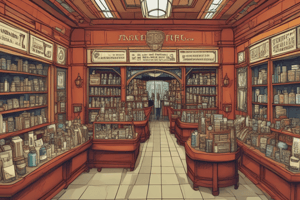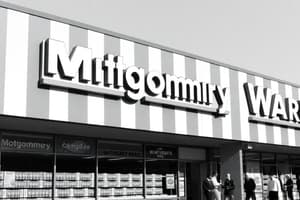Podcast
Questions and Answers
What are the three types of capitalism identified?
What are the three types of capitalism identified?
Production capitalism, Consumption capitalism, Emotional capitalism
What was introduced in the retail sector between 1960-1965?
What was introduced in the retail sector between 1960-1965?
- Self-service
- Supermarkets and hypermarkets (correct)
- Cash & carry
- Specialized distribution
Which of the following options describes a key strategy of distribution from 1915-1945?
Which of the following options describes a key strategy of distribution from 1915-1945?
- Focus on margins of individual products
- Emotional marketing
- Segmentation of products (correct)
- Acceleration of mass production (correct)
The retail sector moved from 'Fordism' to _____ during the early to mid-20th century.
The retail sector moved from 'Fordism' to _____ during the early to mid-20th century.
Self-service was introduced in the retail sector after 1945.
Self-service was introduced in the retail sector after 1945.
What is a primary advantage of distribution in retail?
What is a primary advantage of distribution in retail?
Which product generates the highest gross margin in euros?
Which product generates the highest gross margin in euros?
Product C has a gross margin percentage of 8%.
Product C has a gross margin percentage of 8%.
What is the gross margin volume of Product A?
What is the gross margin volume of Product A?
The selling price of Product D is __________.
The selling price of Product D is __________.
Match the products with their corresponding gross margin percentages:
Match the products with their corresponding gross margin percentages:
What is the main goal of merchandising?
What is the main goal of merchandising?
The 5R’s of Kepners include the Right product, Right time, and Right place, but not Right information.
The 5R’s of Kepners include the Right product, Right time, and Right place, but not Right information.
List three main aspects of merchandising.
List three main aspects of merchandising.
Merchandising is based on the concept of selling more, selling better, with more _____ .
Merchandising is based on the concept of selling more, selling better, with more _____ .
Match the following aspects of merchandising with their descriptions:
Match the following aspects of merchandising with their descriptions:
Flashcards
Retail Sector History
Retail Sector History
Understanding the evolution of retail from production to consumption and emotional capitalism, highlighting key periods like production capitalism (1820-1945), consumption capitalism (1945-1975), and emotional capitalism (1975-present).
Distribution's Role
Distribution's Role
Distribution bridges the gap between manufacturers and consumers, matching supply with demand, handling logistics, offering a wider product range, and enabling product combinations.
1860 Distribution Organization
1860 Distribution Organization
Early distribution emphasized volume over profit margins, with geographical organization focused on gathering supplies, prioritizing massive sales.
1915-1945 Distribution
1915-1945 Distribution
Signup and view all the flashcards
1960-1965 Retail Emergence
1960-1965 Retail Emergence
Signup and view all the flashcards
Consumer Segmentation
Consumer Segmentation
Signup and view all the flashcards
Distribution Value
Distribution Value
Signup and view all the flashcards
Retail Formats Evolution
Retail Formats Evolution
Signup and view all the flashcards
Merchandising
Merchandising
Signup and view all the flashcards
Emotional Capitalism
Emotional Capitalism
Signup and view all the flashcards
Gross Margin Percentage
Gross Margin Percentage
Signup and view all the flashcards
Gross Margin (in €)
Gross Margin (in €)
Signup and view all the flashcards
Product with Highest Margin (in €)
Product with Highest Margin (in €)
Signup and view all the flashcards
Strategies to Increase Gross Margin
Strategies to Increase Gross Margin
Signup and view all the flashcards
Pricing Elasticity
Pricing Elasticity
Signup and view all the flashcards
Merchandising
Merchandising
Signup and view all the flashcards
5 R's of Kepners
5 R's of Kepners
Signup and view all the flashcards
Merchandising aspects
Merchandising aspects
Signup and view all the flashcards
Point of Sale (POS)
Point of Sale (POS)
Signup and view all the flashcards
Retail Mix
Retail Mix
Signup and view all the flashcards
Study Notes
Distribution and Merchandising
- The presentation covers distribution and merchandising, specifically within the retail sector.
- The presentation is part of a larger course, PGE2, for the academic year 2024/2025.
- The course is structured into parts introducing the retail sector.
Part I: Introduction to Retail
-
The first part of the course is dedicated to understanding the retail sector.
-
Bit of History: The presentation details the evolution of retail from production capitalism (1820-1945) to consumption capitalism (1945-1975) and emotional capitalism (1975-present).
-
Role and Environment of Distribution: The role, encompassing simplification, geographical organization (gathering), prioritizing sales volume, and increasing attractiveness, is crucial. Distribution's environment includes: socio-economic trends, legal considerations (authorizations, consumer protection, buying contracts), technology, and ecology.
-
Business Model of Distribution: The methodology of distribution requires understanding and analyzing the model.
-
Retail Sector Organization: The presentation outlines the retail sector's organization, including various formats and other aspects.
-
Merchandising: The introduction to merchandising provides the basic definition.
A Bit of History
- The slides detail different historical periods of retail, specifically the retail business models.
- Production, consumption, and emotional capitalism—important retail trends and periods according to the study materials.
1860: Organization of Distribution
- The slide outlines the approach to distribution in 1860.
- Key strategies include simplification, geographical organization, prioritizing volume, and developing attractiveness to achieve higher volume sales.
1915-1945: Acceleration - Moving Towards a Better Knowledge of the Consumer
- From 1915-1945, there was an acceleration in retail, moving towards a better understanding of the consumer.
- Mass production techniques, self-service, specialized distribution (franchises) were introduced. The shift from Fordism to Sloanism is a key concept.
1960-1965: The Retail Sector
- The presentation highlights the first emergence of supermarkets and hypermarkets in this period.
- This advancement led to a greater need for partnerships between the retail sector to support logistics.
Consumer, Professional Products, and Active Cosmetics Divisions (L'Oréal Luxe)
- The slide shows different product divisions of a significant business (L'Oréal Luxe, Consumer Products, Professional Products, Active Cosmetics, and The Body Shop, which offer diverse product types).
- Many well-known brands are included.
Evolution of Retail Formats
- A paper on the evolution of retail formats is recommended for further information.
- The reference is an academic journal article.
How Does Distribution Bring Value?
- A diagram illustrates how distributors connect manufacturers and customers, and how they fulfill a crucial role in the supply chain.
- Key advantages of distribution include matching supply and demand, logistics facilitation, providing broader choices, and connecting products.
Different levels of complexity
- The slide outlines the difference between a direct and a more complex "wholesaler/retailer" model.
Environment of the Distribution
- The socio-economic environment, legal aspects (including consumer protection and authorizations), technology (like RFID, cashier systems, consumer behavior analysis), and ecology are critical factors affecting the distribution process.
Video Links
- Several video links appear, which are not included due to the lack of access to videos.
INSIDE WALMART'S NEW AUTOMATION
- This slide shows an image of Walmart as part of an overview of automation.
### Others
- Various other aspects of retail and distribution including a detailed breakdown of the distribution cycle, business models, and other organizational structures are covered including the distribution wheel and strategic analysis of different retail formats.
- The discussion covers detailed points about gross margin calculations, exercises, and questions guiding the students about the different types of business models, KPI's (key performance indicators), and other retail formats (including supermarkets, convenience stores, and more).
- The slides detail the strategic management in retail (Ansoff Matrix), international strategies for retailers, the A/Classification, and the B/Organizations.
- The study notes conclude with summaries of different topics concerning Omni-channel distribution, M-commerce, factors driving geographical settlement, and other relevant topics on retail management and logistics.
A/ Classification
- Type of channel
- Mass, Selective, or Exclusive distribution (types of delivery)
- Types of classification
B/ Organizations
- Independent Stores
- Branch offices
- Cooperatives
- Consumers' groups
- Stores' groups
- Commercial centers/malls
- Franchises
- Licensing
- Concession
Overview of the Retail Worldwide
- The slide presents a summary of the retail sector overview, including the top companies, their origins, revenue figures, and main retail formats.
Walmart
- Walmart's history as a retail giant, its operational model, and key competencies (e.g., logistics) are described.
Omnichannel Distribution, B2C
- Statistics on E-commerce sales increase from 2014-2022.
- The top performing countries by retail e-commerce sales growth from 2022 are listed in the study materials.
M-commerce
- Discussion about mobile commerce, identifying 2022 trends, and comparing mobile vs. computer usage.
Pure Player, click & mortar, Brick & Mortar, Social Selling
- The slides mention different types of retailers (pure online, hybrid, and brick-and-mortar).
Segmentation of the Retail Market
- The presentation identifies approaches, criteria, and segmentation examples (e.g., biscuits, cookies, and light bulbs).
Retail Classification and Organization
- Categorization and organization of retailers by channels and types.
Business Case: Zara
- The case study focuses on Zara's retail business model.
Merchandising: Definition
- Discusses the concept and methods (techniques) used for displaying products to drive sales or increased profitability.
Fundamentals of Merchandising
- Explains the 5R's of effective merchandising (Right Product, Right Time, Right Place, Right Price, and Right Information)
Part 11: Conception of the Point-of-Sales
- A deeper dive into the elements of retail and aspects of setting up a retail environment.
Where to Settle? Geographical Settlement Criteria
- Factors impacting store location decisions: considerations about customer demographics, regulations, competitor locations, and advantages/disadvantages of locations.
Trading Area (Zone de Chalandise)
- The target customer area around a store.
Examples of Geographical Coverage Strategies
- Methods of expansion for retail stores
Experiential Marketing
- Ways to make customer experiences positive in a retail environment (e.g., with particular brands/products and the overall experience/environment in a store).
POS Information (ILV)
- Provides details of the point-of-sale information provided in the store.
Part III: Sales Promotion and Animation
- Techniques to attract customers into buying or trying new and existing products from the retailer.
Sales Promotion Strategy
- Approaches to sales promotions
Different levels of promotions
- The various sources of promotions.
Highlighting on the Shelves / Breaking the Rhythm
- Strategies to highlight products on shelves to increase sales.
In-store Advertising
- Various illustrations of in-store advertisements
Sales Promotion Tools
- Common sales promotion techniques (coupons, premiums, loyalty programs, etc.).
Examples of Customer-Oriented Promotion Tools
- Tactics designed to engage with and encourage customers to try new products.
Premiums/Bonuses, Free Gifts
- Small items given to buyers for purchases.
Bundles
- Combining two different goods with special offers to increase the products to achieve total revenue.
Price Discounts
- Immediate and unconditional pricing reductions.
Coupons
- Pieces of paper that reduce product prices.
Contests, Games, Scratch-and-win Offers
- Techniques used for promotions.
Money-back Offer/Refund/Cashback Offer
- Reimbursing part of the purchase price to customers
Offers Specific to Card Owners (Fidelity)
- Rewarding customers for purchasing or repeated visits through loyalty programs/card programs
Discounts on the cash receipt
- Providing discounts at the cash counter based on customer purchase history/loyalty.
Various
- Other special promotional offers.
Animation
- Techniques to refresh and re-engage customers (seasonal/monthly promotions).
Part IV: E/M-Merchandising
- Techniques used in selling products online
Information for E-Merchandising
- Characteristics of e-merchandising. E-merchandising differs significantly from traditional retail merchandising.
Exercise
- Exercise questions for further discussion.
Navigation Tools
- Tools used to help customers find products online (navigation menus, filters, search engine, etc.).
Reassuring Tools
- Tools to reassure customers about safety of purchases and trust in the online retailer (e.g., payment and delivery methods, reviews).
Optimization Tools
- Techniques used to increase the profitability or efficiency of an offer e.g. recommending similar, complementary items.
Main KPIs
- Key performance indicators (e.g., conversion rate, visitors, bounce rates, etc.)
Synthesis Merchandising
- Summary of merchandising concepts.
Fundamentals of Merchandising
- A summary of the fundamentals.
Studying That Suits You
Use AI to generate personalized quizzes and flashcards to suit your learning preferences.
Related Documents
Description
This quiz explores key concepts in the history of retail, including types of capitalism and important developments in distribution strategies. Test your knowledge on the evolution of the retail sector and notable changes between the early and mid-20th century.





